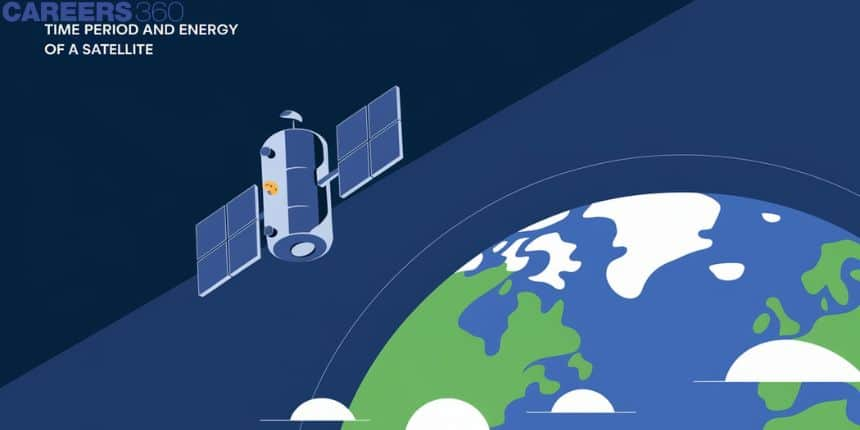Time Period And Energy Of A Satellite
Satellites, whether natural like the Moon or man-made, orbit Earth due to a delicate balance of gravitational pull and velocity. The time period of a satellite, which is the time it takes to complete one full orbit, is a fundamental concept in understanding its motion. This period is influenced by the satellite's altitude and the mass of the Earth. The energy of a satellite, comprising both kinetic and potential energy, determines its speed and orbit stability. In real life, these principles are crucial for the operation of GPS satellites that guide our navigation systems, communications satellites that enable global connectivity, and weather satellites that monitor Earth's climate. Understanding the time period and energy of satellites helps engineers design efficient and reliable systems that are integral to modern technology, ensuring everything from accurate weather forecasts to uninterrupted phone calls.
This Story also Contains
- The Time Period of the Satellite
- Height of Satellite
- The Energy of Satellite
- Binding Energy (B.E.)
- Solved Examples Based on Time Period And Energy of a Satellite

The Time Period of the Satellite
The time period of a satellite is the duration it takes for the satellite to complete one full orbit around a celestial body, such as Earth. This time period is determined by the satellite's altitude and the mass of the celestial body it orbits. According to Kepler's laws of planetary motion, the time period is directly related to the size of the orbit—the higher the satellite, the longer the time period.
The time period (T) of the satellite is given by
Where
If the satellite is very close to the Earth's surface,
i.e.,
The time period of a satellite in terms of density
For a satellite, the time interval between the two consecutive appearances overhead
If a satellite in the equilateral planes moves from west to east Angular velocity of the satellite with respect to an observer on earth will be
So
if
means the satellite will appear stationary relative to Earth.
Height of Satellite
As we know, time period of satellite
Putting the value of the period in the above formula we can calculate the height of the satellite from the surface of the earth.
The Energy of Satellite
When a satellite revolves around a planet in its orbit, it possesses both kinetic energy (due to orbital motion) and potential energy (due to its position against the gravitational pull of Earth). These energies are given by
Potential energy:
Kinetic energy :
Total energy :
Where
And
Energy Graph of Satellite

Where
Energy Distribution in an Elliptical Orbit

In this Total Energy
Where
Binding Energy (B.E.)
The minimum energy required to remove the satellite from its orbit to infinity is called Binding Energy.
And It is given by
where
B.E Binding energy
Work done in changing the orbit
When the satellite is transferred to a higher orbit i.e.

Where
Recommended Topic Video
Solved Examples Based on Time Period And Energy of a Satellite
Example 1: A very long (length L) cylindrical galaxy is made of uniformly distributed mass and has a radius R (R<<L). A star outside the galaxy is orbiting the galaxy in a plane perpendicular to the galaxy and passing through its centre. If the period of the star is T and its distance from the Galaxies axis is r, then :
1)
2)
3)
4)
Solution:
The period of satellite
Here K is some constant
Hence, the answer is the option (3).
Example 2: The relative uncertainty in the period of a satellite orbiting around the earth is
1)
2)
3)
4)
Solution:
Period of satellite
Hence, the answer is the option (2).
Example 3: A spaceship orbits around a planet at a height of 20 Km from its surface. Assuming that only the gravitational field of the planet acts on the spaceship, what will be the number of complete revolutions made by the spaceship in 24 hours around the planet? (Given : Mass of planet
1) 11
2) 17
3) 13
4) 9
Solution:
(
using r=R+h
Hence, the answer is the Option (1).
Example 4: If the satellite whose mass m is revolving in a circular orbit of radius r around the earth (mass of earth =M). The time of the revolution of satellites is:
1)
2)
3)
4)
Solution:
Hence, the answer is the option (2).
Example 5: If the density of the planet is
1)
2)
3)
4)
Solution
The time period of a satellite in terms of density
wherein
As we known
Hence, the answer is the option (4).
Summary
The time period of a satellite depends on its orbit radius and the mass of the planet, following Kepler's laws. It is influenced by gravitational forces and can be calculated using specific formulas that account for satellite altitude and Earth's mass. The satellite's energy consists of kinetic and potential energy, which together determine orbit stability. Understanding these factors helps in applications like GPS, communication, and weather satellite